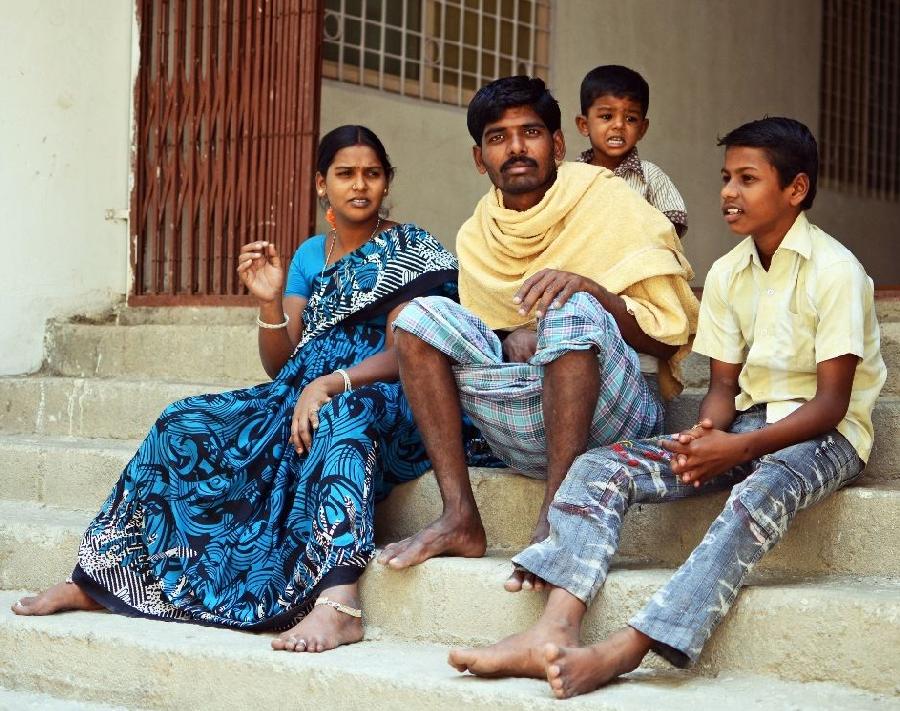
Indian Boys' Clothes: Children's Clothing

Figure 1.-- Here we see a middle-class Indian family, An Indian family in front of their home, probably somewhere in the South during 2014. We suspect that they came from more humble origins and are benefitting from the market reforms that are transforming the Indian economy. We can see the changing clothing trends at work in India. The parents are wearing sari and dhoti and the children western style garments. And notably the childrn are not wearing school uniforms, but rather Western garments that they seem to prefer. A reader writes, "We can see that the boys dressed in western clothing, but barefoot. Even the older boy who clearly is fashion concious doesn't see footwear as an essential garment.
Economic conditions are surely an important element, but cultural ideas are also important and not always affected by economic considerations." In America of course, boys this age would place sneakers near the top of their fashion choices.
|
|
Children's clothing often lead fashion trends. This is because the clothes that children wear when young often affect fashion choices when they grow up. Since the environmental situation has always been the main factor to define the type of clothing, grown ups and children wore - and in many cases still wear - similar clothes. Only school uniform has created a new style like in many countries influenced by the British and Iberian culture: boys wear kakhi or blue shorts and white shirt, girls a similar short skirt and white blouse. This is true only for higher schools, not for everybody. New is that boys do not wear some kind of skirt to school but short pants, and girlsīskirt is much shorter than in traditional - and still home- - clothing. In small village schools they wear ther common clothes: the girls a long skirt, a sari or the Punjabi dress plus blouse, the boys the lungi as usual. When the children come home from school, they have to take a shower, often meaning dosing themselve with water kept in a cool spot in the home, and put on traditional clothes - at least in more traditional families and casts such as brahminical casts. This may create a feeling af safety in the social layer they belong to. In villages and the common and mostly low cast-families this is not taken that much serious: children wear a piece of cloth (white or patterned) wound around the waist. For girls it resembles a real skirt, but for boys it is rather this piece of cloth which can be folded up as can be seen in some of my photographs to make it shorter and more comfortable and cooler for play. Often when a stranger appears thy let the lungi fall to full length. We notice in India an increasing trend away from traditiinal styles tgoward Western dres. Here a range of factors are at play. Two of the most important are practicality and India's phenomenal economic growth. Large numbers of Indians have bebefitted and joined the midke class with more disposal income which means that they can aford to dress better. Another factor is that the growing middle class often sees Western cloyhing as a sign of boith afflence and modernity.
HBC

Navigate the Boys' Historical Clothing Web Site:
[Introduction]
[Activities]
[Biographies]
[Chronology]
[Clothing styles]
[Countries]
[Topics]
[Bibliographies]
[Contributions]
[FAQs]
[Glossaries]
[Images]
[Links]
[Registration]
[Tools]
[Boys' Clothing Home]
Navigate the Boys' Historical Clothing national pages:
[Return to the Main Indian country page]
[Return to the Main countries page]
[Return to the Main Indian page]
[Return to the Main Asian page]
[Afghanistan]
[Bangladesh]
[Bhutan]
[Burma]
[China]
[Iran]
[Nepal]
[Pakistan]
[Sri Lanka]
[Tajikistan]
[Tibet]
[Turkmenistan]
[Uzbeckistan]
Created: 10:25 PM 3/8/2015
Last updated: 8:54 AM 3/9/2015



